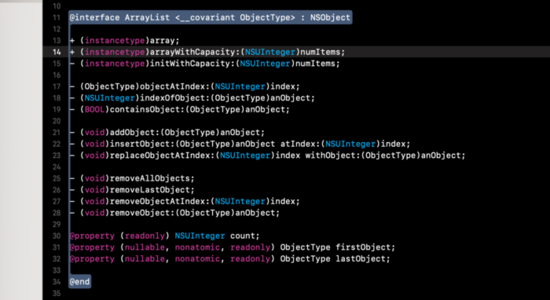ios 数据结构数组 iOS 数据结构之数组的操作方法
人气:0数组是线性结构是容器类型,是一块连续的内存空间, iOS 中用 NSArray 和 NSMutableArray 集合类型,用来存放对象类型,其中 NSArray是不可变类型, NSMutableArray 是可变类型,能够对数组中元素进行增删改查.
本文作者本着学习的态度,决定仿照NSArray和NSMutableArray 自己实现一个数组类型,当然性能可能没有 NSArray和NSMutableArray 的好,插入100000万条数据,时间上是 NSMutableArray 的三倍左右 ,当然平时使用过程中很少100000次这样大的数据往数组里添加,因此性能方面可以忽略.
ArrayList.h 主要方法声明 完全照搬 NSArray 和 NSMutableArray 的方法名称

先发下测试结果
dispatch_async(dispatch_get_global_queue(0, 0), ^{
Person *p1 = [[Person alloc] init];
NSMutableArray *array = [NSMutableArray arrayWithCapacity:100000];
// ArrayList
*array = [ArrayList arrayWithCapacity:100000];
CFAbsoluteTime startTime =CFAbsoluteTimeGetCurrent();
for (int i = 0; i<100000; i++) {
[array addObject:p1];
}
CFAbsoluteTime linkTime = (CFAbsoluteTimeGetCurrent() - startTime);
CFTimeInterval duration = linkTime * 1000.0f;
NSLog(@"Linked in %f ms",duration);
[self->_timeArray addObject:@(duration)];
count++;
});
NSMutableArray 5.081740292635832 ms
ArrayList 16.27591523257168 ms
以下是 ArrayList 的具体实现 ,内部是一个 C语言的数组用来存放对象
//
// ArrayList.m
// ArrayList
//
// Created by dzb on 2018/7/19.
// Copyright © 2018 大兵布莱恩特. All rights reserved.
//
#import "ArrayList.h"
static NSInteger const defaultCapacity = 10;
typedef void * AnyObject;
@interface ArrayList ()
{
AnyObject *_array;
NSInteger _size;
NSInteger _capacity;
}
@end
@implementation ArrayList
#pragma mark - init
- (instancetype)init
{
self = [super init];
if (self) {
[self resetArray];
}
return self;
}
+ (instancetype)array {
return [[ArrayList alloc] initWithCapacity:defaultCapacity];
}
+ (instancetype)arrayWithCapacity:(NSUInteger)numItems {
return [[ArrayList alloc] initWithCapacity:numItems];
}
- (instancetype)initWithCapacity:(NSUInteger)numItems {
_capacity = numItems;
_array = calloc(_capacity,sizeof(AnyObject));
_size = 0;
return self;
}
/**
数组重置
*/
- (void) resetArray {
_size = 0;
if (_array != NULL)
_array[_size] = NULL;
free(_array);
_capacity = defaultCapacity;
_array = calloc(_capacity, sizeof(AnyObject));
}
#pragma makr - 增加操作
- (void)addObject:(id)anObject {
[self insertObject:anObject atIndex:_size];
}
- (void)insertObject:(id)anObject atIndex:(NSUInteger)index {
if (!anObject) {
@throw [NSException exceptionWithName:@"add object null." reason:@"object must be not null ." userInfo:nil];
return;
}
///判越界
if ((index > _size)) {
@throw [NSException exceptionWithName:@"Array is out of bounds" reason:@"out of bounds" userInfo:nil];
return;
}
if (_size == _capacity-1) { ///判断原来数组是否已经满了 如果满了就需要增加数组长度
[self resize:2*_capacity];
}
///交换索引位置
if (self.count > 0 ) {
for(NSInteger i = _size - 1 ; i >= index ; i--)
_array[i + 1] = _array[i];
}
self->_array[index] = (__bridge_retained AnyObject)(anObject);
_size++;
}
#pragma mark - 删除操作
- (void)removeAllObjects {
NSInteger i = _size-1;
while (_size > 0) {
[self removeObjectAtIndex:i];
i--;
}
[self resetArray];
}
- (void)removeObjectAtIndex:(NSUInteger)index {
///判断越界
if ((index > _size)) {
@throw [NSException exceptionWithName:@"Array is out of bounds" reason:@"out of bounds" userInfo:nil];
return;
}
AnyObject object =(_array[index]);
CFRelease(object);
for(NSInteger i = index + 1 ; i < _size ; i ++)
_array[i - 1] = _array[i];
_size--;
_array[_size] = NULL;
///对数组空间缩减
if (_size == _capacity/2) {
[self resize:_capacity/2];
}
}
- (void)removeObject:(id)anObject {
NSInteger index = [self indexOfObject:anObject];
if (index == NSNotFound) return;
[self removeObjectAtIndex:index];
}
- (void)removeLastObject {
if ([self isEmpty]) return;
[self removeObjectAtIndex:_size-1];
}
#pragma mark - 修改操作
- (void)replaceObjectAtIndex:(NSUInteger)index withObject:(id)anObject {
if (!anObject) {
@throw [NSException exceptionWithName:@"add object null." reason:@"object must be not null ." userInfo:nil];
return;
}
///判断越界
if ((index > _size)) {
@throw [NSException exceptionWithName:@"Array is out of bounds" reason:@"out of bounds" userInfo:nil];
return;
}
_array[index] = (__bridge AnyObject)(anObject);
}
#pragma mark - 查询操作
- (BOOL) isEmpty {
return (self->_size == 0);
}
- (BOOL) isFull {
return (self->_size == self->_capacity-1);
}
- (id)objectAtIndex:(NSUInteger)index {
if ((index > _size)) {
@throw [NSException exceptionWithName:@"Array is out of bounds" reason:@"out of bounds" userInfo:nil];
return nil;
}
if ([self isEmpty]) { return nil; }
AnyObject obj = _array[index];
if (obj == NULL) return nil;
return (__bridge id)(obj);
}
- (NSUInteger)indexOfObject:(id)anObject {
for (int i = 0; i<_size; i++) {
id obj = (__bridge id)(_array[i]);
if ([anObject isEqual:obj]) return i;
}
return NSNotFound;
}
- (BOOL)containsObject:(id)anObject {
for (int i = 0; i<_size; i++) {
id obj = (__bridge id)(_array[i]);
if ([anObject isEqual:obj]) return YES;
}
return NO;
}
- (id)firstObject {
if ([self isEmpty]) return nil;
return (__bridge id _Nullable)(_array[0]);
}
- (id)lastObject {
if ([self isEmpty]) return nil;
return (__bridge id _Nullable)(_array[_size]);
}
- (NSUInteger)count {
return _size;
}
- (NSString *)description {
NSMutableString *string = [NSMutableString stringWithFormat:@"\nArrayList %p : [ \n" ,self];
for (int i = 0; i<_size; i++) {
AnyObject obj = _array[i];
[string appendFormat:@"%@",(__bridge id)obj];
if (i<_size-1) {
[string appendString:@" , \n"];
}
}
[string appendString:@"\n]\n"];
return string;
}
/**
对数组扩容
@param capacity 新的容量
*/
- (void) resize:(NSInteger)capacity {
AnyObject *oldArray = _array;
AnyObject *newArray = calloc(capacity, sizeof(AnyObject));
for (int i = 0 ; i<_size; i++) {
newArray[i] = oldArray[i];
}
_array = newArray;
_capacity = capacity;
free(oldArray);
}
- (void)dealloc
{
if (_array != NULL)
[self removeAllObjects];
free(_array);
// NSLog(@"ArrayList dealloc");
}
@end
经过测试 数组内部会对存入的对象 进行 retain 操作 其引用计数+1 ,当对象从数组中移除的时候 能够正常的使对象内存引用计数-1,因此不必担心对象内存管理的问题. 数组默认长度是10 , 如果在开发者不确定数组长度时候 ,其内部可以动态的扩容增加数组长度,当执行 remove 操作时候 也会对数组内部长度 进行相应的缩减
实现了 NSArray 和 NSMutableArray 等常用API,如果不是对性能特别在意的场景下 ,可以使用 ArrayList 来存放一些数据
加载全部内容